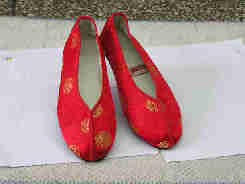The "Sifting Shoes" Custom

There is an interesting custom called "sifting shoes" among today's Zhuang Ethnic Minority people today. When two young people get married, the bride's sisters escort her to the bridegroom's family. Then a wedding ceremony is held, in which the bride and bridegroom make formal bows to the groom's parents. After that, the escorts sing songs together before the bridegroom's family lay out the wedding banquet, during which the ritual of tea or wine serving is held. As the escorts are beginning to take leave, a young man brings out a sift (container of sort) and begins "sifting shoes".
Usually, the escorts will decline politely before putting the shoes they bring with themselves into the sift. Every time the man receives a pair of shoes, he will put a red packet into the container and then presents it to the escort as he shakes the container and sings songs of gratitude. He does this until he has "sifted" shoes into red packets for all the escorts.
Auspicious Wedding Shoes
During the wedding ceremony, the bride usually wears special wedding shoes. For example, in Southern Fujian Province, the bride has to wear a pair of shoes embroidered with patterns of a turtle or a deer, which symbolizes blessing, happiness, and longevity after marriage.
In southern Zhejiang Province, making shang jiao xie (shoes worn while stepping into the sedan chair) before getting into the sedan is akin to praying for auspiciousness.
Either the bride or others can make the wedding shoes. These kinds of shoes are made with red and green cloth and usually with a soft sole, and are worn by the bride as she steps into the sedan chair. In some places, relatives who are thought to have good fortune make such shoes, while in other areas, they are made by the bride and another single girl on the morning of the wedding day.

All about Wedding Shoes
In the Haizhou Region of East China's Jiangsu Province, wedding shoes are known as xi xie or "happy shoes". Before liberation (in 1949), when a girl was getting married, she usually wore a pair of happy shoes, which were made with red cloth or silk and were sometimes embroidered with flower patterns in the front part. With the increasing appearance of leather shoes after liberation, the bridal wedding shoes gave way to the leather ones. The bridegroom's first pair of shoes after marriage should be made or bought by the bride.
In the Longquan Area of Sheeting Province, there are many regulations on the bride and bridegroom's wedding shoes. For example: The bride usually wears pink or orange wedding shoes, which are made by a girl whose parents are still alive or a grandma who has witnessed three generations. The front uppers are embroidered with a pair of phoenixes picking peony flowers. Inside the shoes is a lining of white cloth, on which is embroidered a pair of the Chinese character "喜," meaning happiness.
On the wedding day, the bride wears this pair of shoes to get on and off the sedan chair, as well as for the following three days. After that, the shoes will be put away. When the first child she bears reaches one month old, she wears this pair of shoes to meet guests to show that she is a first-time mother. The bridegroom's shoes, on the other hand, are made with black cloth by the same kind of people who make the wedding shoes for the bride, and can be worn until they are worn out.
Variety of Wedding Shoes
Wedding shoes have different names in different places.
In ancient times, wedding shoes were also called " Zodiac Shoes", since a propitious date was chosen for the wedding ceremony. When getting on the sedan chair, the bride always wore a pair of yellow shoes, which were changed to red ones upon her arrival at the bridegroom's family.
In some places, wedding shoes refer to shoes worn while making formal bows to the bridegroom's parents at the traditional wedding ceremony, and are therefore named cai tang xie or "stepping hall shoes". In other places, wedding shoes refer to those worn by the bride when changing her hairstyle on the wedding day, featuring a thin sole, red lining, and embroidered flower patterns. After that, the bride has to change to another pair of shoes, and throw the wedding shoes under the bed to show her determination of not marrying again.
In the old days, the bride often wore a pair of soft-sole shoes when spending the night in the nuptial chamber softened by candlelight. When in bed, the bridegroom would take off the shoes for the bride, and then look at the drawings inside the shoes together.
There is another kind of wedding shoes called hui men shoes". A month after marriage, the brides' family usually invites the bride to live with them for several days, which is known as hui men. The bride can live there for a month if accompanied by the bridegroom. Otherwise, she can only live as long as her mother-in-law allows, usually eight or eighteen days. During her stay at her parents' home, the bride has to make each member of the bridegroom's family a pair of shoes, which are the so-called hui men shoes.










